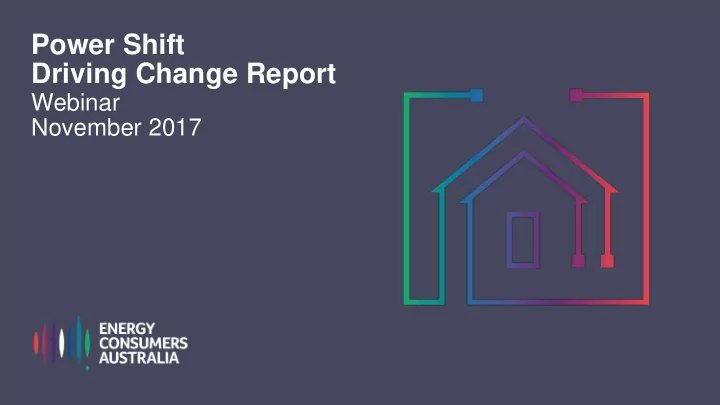

Power Shift Driving Change Report Webinar November 2017
Power Shift – Helping consumers manage their energy usage
Power Shift Objectives • Improve our evidence-based understanding of what really works in supporting vulnerable consumers to manage their energy bills (the research outcome). • Identify opportunities for market-led solutions and other initiatives to support vulnerable consumers to manage their energy bills (the empowering consumers outcome). ECA presentation to EEC November 2017 4
Energy Consumers Australia To promote the long term interests of consumers of energy with respect to the price, quality, safety, reliability and security of supply of energy services by providing and enabling strong, coordinated, collegiate evidence-based consumer advocacy on National Market matters of strategic importance or material consequence for Energy Consumers, in particular Residential Customers and Small Business Customers. ECA presentation to EEC November 2017 5
…affordability continues to be critical Australian Energy Update , Figure 3.6 http://www.environment.gov.au/en ergy/publications/australian- energy-update-2017 6
2016/17 Research 7
Power Shift 2017/18 work program • Research: ‐ Retail market barriers to energy management goods/services ‐ Mapping customer decision-making • Digital platform to share consumer resources • Housing – how best to inform policy development • Health – communicating LIEEP learnings to health sector. 8
Power Shift Project 1: Driving Change Identifying what caused low-income consumers to change behaviour Professor Rebekah Russell‐Bennett Dr Rowan Bedggood
1 Overview of LIEEP Reports
Overview of the Deep Dive Process
Locations and Number of LIEEP Participants Captured in LIEEP Reports
Number of LIEEP Participants by Cohort
Initiatives Trialled
Average Daily Household Electricity Use Per Initiative
Behavioural Improvements Per Initiative
2 Segments: Profiling LIEEP Participants
Motivators and Barriers to Adopting Energy Efficiency Practices
Recommendations for Segmentation
Segmentation Approach
LIEEP Projects According to Segment
‘New to Energy’
‘Energy Without Effort’
‘Stressed About Energy’
3 Insights from LIEEP
LIEEP Program Delivery Framework
Key Insights – Stage One: Targeted Recruitment
Key Insights – Stage Two: Engagement Tactics
Key Insights – Stage Three: Education and Awareness
Key Insights – Stage Four: Behaviour Change Approach
Key Insights – Stage Five: Energy Outcomes
Stakeholder level insights: Co-ordinating Stakeholders of Energy Efficiency Programs
Power Shift Project 2: Delving into the Co-Benefits Identified in the LIEEP Reports Dr Rowan Bedggood
4 Overview of Co-Benefits
20 projects provided 19 projects empirically captured at least one co‐benefit their insights Empirical Anecdotal Empirical 1. Extraction of 2. Extraction of 3. Extraction of Key Quantitatively Qualitatively Measured Insights of Broader Co- Measured Co-Benefits Co-Benefits Findings benefits Findings 9 co‐benefits 16 co‐benefits 12 co‐benefits 5 projects 20 projects 17 projects
5 Empirically Measured Co-Benefits
10 projects, n = 4806 households 5 regions, 6 cohorts
5 projects, n = 2284 households 3 regions, 2 cohorts
5 projects, n = 2088 households 5 regions, 5 cohorts
3 projects, n = 839 households 3 regions, 3 cohorts
4 projects, n = 2260 households 2 regions, 4 cohorts
9 projects, n = 3476 households 7 regions, 4 cohorts
10 projects, n = 2802 households 4 regions, 4 cohorts
4 projects, n = 2240 households 3 regions, 3 cohorts
2 projects, n = 629 households 2 regions, 2 cohorts
4 projects, n = 500 households 3 regions, 3 cohorts
11 projects, n = 4082 households 7 regions, 5 cohorts
Confidence Perceived Competency Control/Self Efficacy Empower- Financial ment Control Initiatives Interest in Stimulating Knowledge Energy Efficiency Co-Benefits HEV + Retrofit: Positive Minor Thermal Attitude to Comfort Energy Efficiency Quant + Qual Financial Perceived Quant only Stress Comfort Reduction Stress Reduction
6 Anecdotal Co-Benefits & Conclusion
• Social Inclusion • Physical, Mental and Emotional Health and Wellbeing • Increased Disposable Income • Quality of Life • Overcoming Physical Barriers Household Co- • Referral to Additional Services Benefits • Family Benefits • Employment Opportunities • Health Care System • English language improvements for CALD • Unity and Confidence Social Co- • Ethical Recycling Benefits • Cultural Awareness and Understanding • Experience • Network Establishment • Boost to the Industry Consortia Co- Benefits
SUMMARY: Co-benefits analysis = efforts that focus solely on reducing household energy use may miss the mark Capacity • Tenants : cannot replace fixed appliances • Funds : cannot usually afford to buy those they can • Current low consumption levels : lower energy use could turn the home from cold in winter to freezing if the heating is already used to a minimum to keep bills down Capability • Selecting appropriate appliances: low knowledge and complex offerings of appliances • Complex sector: offerings poorly understood by those who most need them
Recommend
More recommend